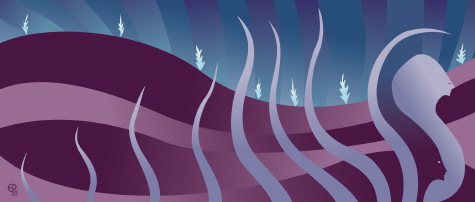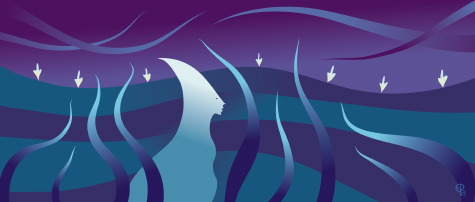Between finishing Lunar Threads in the spring of 1998 and starting Ghost Trees in November 2001, most of my practice was focussed on making physical work in the form of painted and carved wood assemblages. I hadn’t abandoned the computer, I had just not been using it as a creative tool in my art practice. I had been using it occasionally for scanning drawings, trying colour treatments, and designing exhibition announcements, documentation and such, but it was primarily a tool for indirectly assisting with the practice, rather than a medium in which to execute work. Concurrent with this I was working as a freelance graphic designer, illustrator, and web developer.
What I call ghost trees are a kind of amalgamation of will ‘o wisps with trees, and had been appearing in my drawings for quite some time. They serve much the same purpose that the images of pyramids, stars, and the moon did in Pyramid Suite, and that the moon did in Lunar Threads. That is, they are a visual thematic link. Because they were a seemingly important recurring motif in my drawings I decided to let them have their own series.
This was the first body of work since Lunar Threads that I had conceived of as a series. The source sketches are from 1999, and the digital pieces were completed between 21 November 2001 and 4 January 2002. The decision to try another series—digital or otherwise—was based on the fact that the drawings I wanted to work with had an apparent thematic connection. I decided to work digitally for this series because on the one hand the computer made serial work easy and on the other hand I wanted to test the waters, so to speak, to see if I would again experience the frustrations that had led me to stop working digitally in 1998.
When I posted the six images in this series to my web site in 2002, I noted that these were the first images from what I thought was a series-in-progress. Whereas I had intentionally stopped working on my previous digital series—even when there were possibilities for future expansion of each—at the time I fully intended to expand Ghost Trees beyond the initial six images. Unlike my previous digital series—in which I had already chosen images for further work but intentionally not pursued them—with Ghost Trees it was outside factors that kept me from making more pieces. Among these factors were the preparations for an exhibition of my painted wood assemblages at the Saskatchewan Craft Council in early 2002, and my Crossroads project later that year. On top of this studio work, by the fall of 2002 my wife and I had begun setting things in motion for our move to Japan, which took place in the summer of 2003. Simply put, I didn’t have time to make more digital work.
The images are made at a 2.35:1 aspect ratio. This is a cinematic standard for widescreen movies that’s also known as “anamorphic scope” or “scope.” I decided on this ratio after having made a few short experimental animations based on Lunar Threads and Conversations. In these animation projects I found that I would have preferred the wide panoramic vistas possible with cinematic widescreen ratios over the near-TV proportions of my earlier digital series. While I had no specific intention to animate these new Ghost Trees pieces, I wanted to keep the possibility open in case I recanted my opinions against non-narrative animations.
In many ways I see Ghost Trees as a warm-up for my 2005-2006 Encounters project. Changing the image proportions to anamorphic scope presented the challenge of interpreting 10″ x 8″ (25cm x 20cm) drawings into a completely different shape. The files are 8.5″ x 3.167″ (21.25cm x 7.918cm), which is radically different from the sketches. In dealing with the format change, I found that it made the most sense for me to distribute the compositional elements from the sketches across the wider frame, and sometimes add new elements. In some cases I also stretched the parts horizontally but I always did this carefully to ensure that there wasn’t significant visual distortion. As with my other digital pieces my intention was for larger display than the smaller, more manageable document sizes I assigned to my working files. My output experiments with this series include some prints at 36.75″ x 16.75″ (91.875cm x 41.875cm)—the maximum width of my printer—on art paper as well as semi-transparent vellum intended for backlit display.

Ghost Trees 1: Undulant (completed between 2001-2002)
Digital media, variable size (1.4:1 aspect ratio)

Ghost Trees 2: Totem (completed between 2001-2002)
Digital media, variable size (1.4:1 aspect ratio)

Ghost Trees 3: Water Spirits (completed between 2001-2002)
Digital media, variable size (1.4:1 aspect ratio)

Ghost Trees 4: Ophidia (completed between 2001-2002)
Digital media, variable size (1.4:1 aspect ratio)

Ghost Trees 5: Temple (completed between 2001-2002)
Digital media, variable size (1.4:1 aspect ratio)

Ghost Trees 6: Vortex (completed between 2001-2002)
Digital media, variable size (1.4:1 aspect ratio)

Original sketch for Ghost Trees 6: Vortex (04 October 1999)
Ink on Paper, 5.5″ x 8.5″